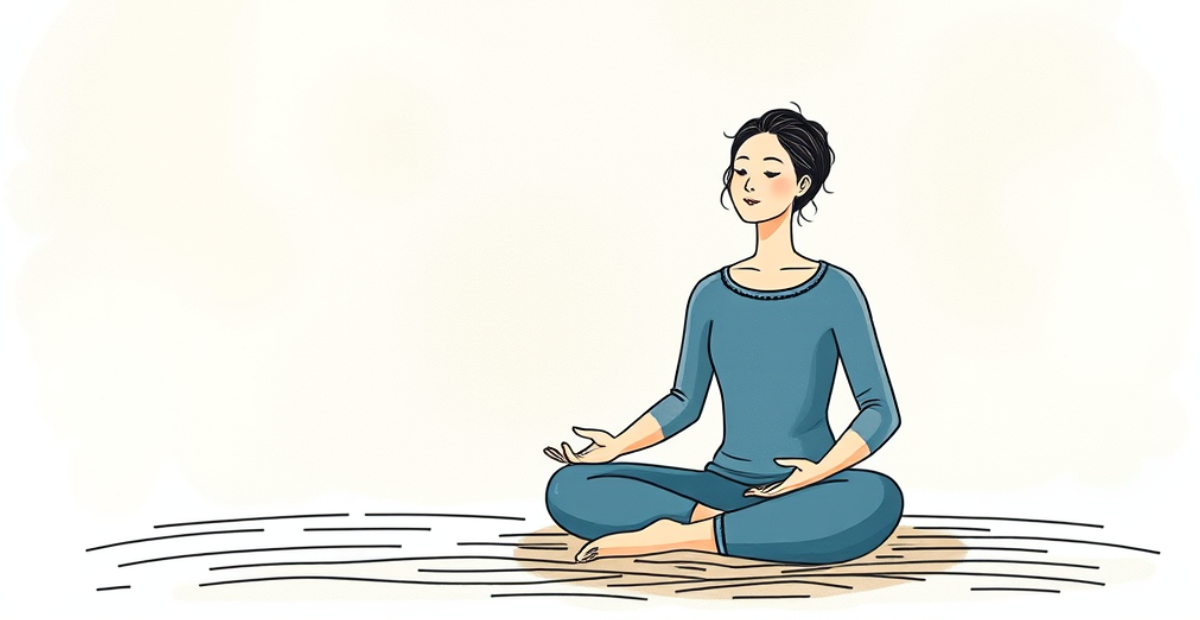10 Powerful Mindfulness Exercises for Instant Calm
In today’s fast-paced world, the constant barrage of notifications, deadlines, and responsibilities can leave us feeling overwhelmed and scattered. Amidst this chaos, mindfulness exercises have emerged as powerful tools to help us reclaim our mental clarity and emotional balance. But what exactly is mindfulness, and how can specific practices help you manage stress while sharpening your focus?
According to research published in the Journal of Clinical Psychology, regular mindfulness practice can reduce stress by up to 40% and significantly improve attention spans. Yet many people still view mindfulness as too time-consuming or complicated to incorporate into their busy lives.
This guide will walk you through 10 scientifically-backed mindfulness exercises that can be practiced in as little as one minute, making them accessible even on your busiest days. Whether you’re a mindfulness novice or looking to refresh your practice, these techniques will help you cultivate greater presence and peace in your everyday life.
The Science Behind Mindfulness
Before diving into specific exercises for mental clarity, it’s worth understanding why mindfulness works. According to neuroscientists at Harvard Medical School, regular mindfulness practice actually changes the physical structure of your brain.
MRI scans show that after eight weeks of consistent mindfulness practice:
- The amygdala (your brain’s stress center) shrinks
- The prefrontal cortex (responsible for focus and decision-making) strengthens
- The connection between these areas improves, enhancing emotional regulation
These changes explain why mindfulness exercises don’t just temporarily make you feel calmer—they fundamentally alter your brain’s response to stress while boosting your capacity for sustained attention.
Mindfulness Exercise #1: The One-Minute Breath
Perfect for: Beginning your day or transitioning between tasks
This simple mindfulness activity takes just 60 seconds but can reset your nervous system and bring you back to center when you’re feeling overwhelmed.
How to practice:
- Sit comfortably with your back straight and close your eyes if possible
- Breathe in slowly for a count of four
- Hold your breath gently for a count of two
- Exhale completely for a count of six
- Repeat this pattern for one minute (about 5 cycles)
What makes this exercise effective is the longer exhale, which activates your parasympathetic nervous system—the body’s natural relaxation response. A study in the Journal of Alternative and Complementary Medicine found that this breathing pattern can reduce cortisol levels (your stress hormone) by up to 23% in just one minute.
Mindfulness Exercise #2: The Five Senses Check-In
Perfect for: Grounding yourself during anxious moments
When stress takes over, we often get caught in a loop of worried thoughts. This stress-relieving mindfulness technique uses your senses as anchors to bring you back to the present moment.
How to practice:
- Pause and take a deep breath
- Notice 5 things you can see around you (be specific about colors and shapes)
- Acknowledge 4 things you can touch or feel (your clothing, the temperature, etc.)
- Become aware of 3 things you can hear (both near and far sounds)
- Identify 2 things you can smell (or would be able to smell if you could)
- Note 1 thing you can taste (even if it’s just the inside of your mouth)
Dr. Judson Brewer, Director of Research and Innovation at Brown University’s Mindfulness Center, explains that this exercise works by “shifting neural activity from the narrative centers of the brain to the sensory processing regions,” effectively interrupting the stress cycle.
Mindfulness Exercise #3: Mindful Walking
Perfect for: Afternoon energy slumps or clearing mental fog
Many people mistakenly believe that mindfulness practices for focus require sitting still. However, mindful walking combines the benefits of physical movement with present-moment awareness, making it ideal for restoring mental clarity.
How to practice:
- Choose a short path (even walking around your office or home works)
- Walk at a slightly slower pace than normal
- Pay attention to the sensation of your feet touching and leaving the ground
- Notice the movement of your legs, arms, and posture
- When your mind wanders, gently redirect your attention to the physical sensations of walking
A Stanford University study found that walking mindfully for just 10 minutes can boost creative thinking by an average of 60% compared to sitting. This makes it a perfect exercise for mental clarity when you’re feeling stuck or unfocused.
Mindfulness Exercise #4: The Body Scan
Perfect for: Releasing physical tension and improving sleep quality
Many of us carry stress in our bodies without realizing it. This mindfulness exercise helps you identify and release physical tension while developing greater bodily awareness.
How to practice:
- Lie down or sit comfortably
- Close your eyes and take a few deep breaths
- Begin by bringing attention to your feet, noticing any sensations
- Slowly move your attention upward through each part of your body (legs, hips, abdomen, chest, etc.)
- For each area, notice any tension and imagine your breath flowing into that space
- As you exhale, visualize the tension melting away
According to research published in Sleep Science, people who practiced a 10-minute body scan before bed fell asleep an average of 20 minutes faster than those who didn’t. This makes it one of the most effective stress-relieving mindfulness techniques for those struggling with sleep issues.
Mindfulness Exercise #5: Mindful Listening
Perfect for: Improving relationships and communication
While many mindfulness exercises focus on self-awareness, mindful listening extends these benefits to your interactions with others. This practice can transform your conversations and deepen your connections.
How to practice:
- During a conversation, set the intention to fully listen
- Turn your body toward the speaker and make appropriate eye contact
- Notice when your mind starts planning what to say next or making judgments
- Gently return your attention to the speaker’s words, tone, and expressions
- Before responding, take a breath and consider what was actually said
Research from UCLA’s Mindful Awareness Research Center suggests that mindful listening can improve relationship satisfaction by up to 23%. The practice helps us truly hear others rather than simply waiting for our turn to speak.
Mindfulness Exercise #6: The Mindful Minute
Perfect for: High-stress moments when you have very little time
Sometimes, life doesn’t allow for extended practice. This simple mindfulness activity can be done anywhere, anytime, without anyone even noticing.
How to practice:
- Set a timer for one minute (or use approximately 15-20 breaths)
- Focus all your attention on your breathing
- Don’t try to change your breath—simply observe it
- When your mind wanders (which it will), gently bring it back to the breath
- After the minute ends, notice how your mental state has shifted
Neurologist Dr. Martin Rossman calls this “emergency stress management” and notes that even these brief interventions can reduce blood pressure and heart rate measurably when practiced regularly.
Mindfulness Exercise #7: Mindful Eating
Perfect for: Developing healthier eating habits and greater food appreciation
In our rush to get through meals, we often miss the experience entirely. This mindfulness practice for focus helps you slow down and truly enjoy your food while improving digestion.
How to practice:
- Choose a small portion of food (even a single raisin works)
- Examine it visually as if you’ve never seen it before
- Notice the smell, texture, and weight
- Take a small bite and chew slowly, observing the flavors and sensations
- Notice how the experience changes as you continue eating
A study in the Journal of Academy of Nutrition and Dietetics found that people who practiced mindful eating consumed an average of 300 fewer calories per meal without feeling less satisfied. Beyond weight management, this practice helps us rediscover the pleasure of eating.
Mindfulness Exercise #8: The STOP Technique
Perfect for: Breaking negative thought patterns or emotional reactivity
When emotions run high, this acronym-based mindfulness exercise can help you regain your composure before saying or doing something you might regret.
How to practice:
- S: Stop what you’re doing
- T: Take a few deep breaths
- O: Observe what’s happening in your body, mind, and emotions
- P: Proceed with greater awareness
Psychologist Daniel Goleman, author of “Emotional Intelligence,” explains that this brief intervention creates what he calls an “amygdala hijack interrupter,” preventing the emotional center of your brain from overriding your rational thinking.

Mindfulness Exercise #9: Loving-Kindness Meditation
Perfect for: Counteracting negativity bias and improving mood
While many stress-relieving mindfulness techniques focus on awareness, this practice actively cultivates positive emotions toward yourself and others.
How to practice:
- Sit comfortably and close your eyes
- Begin by directing kind wishes toward yourself: “May I be happy, may I be healthy, may I be safe, may I live with ease”
- Next, extend these same wishes to someone you care about
- Continue expanding your circle to include acquaintances, difficult people, and eventually all beings
Research from Stanford’s Center for Compassion and Altruism Research and Education found that just seven minutes of loving-kindness meditation can increase feelings of social connection and positive emotions by significant margins.
Mindfulness Exercise #10: Mindful Technology Use
Perfect for: Reducing digital overwhelm and reclaiming attention
In our hyper-connected world, this mindfulness practice for focus helps you use technology more intentionally.
How to practice:
- Before checking your phone or opening an app, pause and take a breath
- Ask yourself: “Why am I reaching for my device right now?”
- Set a clear intention for what you want to accomplish
- Notice any urges to switch tasks or keep scrolling
- When finished, completely close the app and take another conscious breath
Digital wellness expert Dr. Larry Rosen found that people who practiced mindful technology use reported 35% less anxiety and showed improved ability to focus on complex tasks.
FAQ About Mindfulness Exercises
How long do I need to practice mindfulness to see benefits?
While research from the University of Wisconsin-Madison suggests that changes in brain activity can be observed after just 8 minutes of mindfulness practice, consistent benefits typically emerge after 2-3 weeks of daily practice. Even 5-10 minutes per day can produce noticeable improvements in stress levels and focus.
Can mindfulness exercises help with specific conditions like anxiety or ADHD?
Yes. Multiple clinical studies have shown that specific mindfulness exercises can be particularly effective for certain conditions:
- For anxiety: The Body Scan and STOP Technique show strongest results
- For ADHD: Mindful Walking and short, frequent attention practices work best
- For chronic pain: Body Scan and Loving-Kindness Meditation are most beneficial
However, it’s important to note that mindfulness should complement, not replace, professional treatment for diagnosed conditions.
I find it difficult to sit still. Are there active mindfulness practices?
Absolutely! Mindfulness practices for focus don’t require sitting still. Besides Mindful Walking, consider:
- Mindful stretching or yoga
- Mindful dishwashing or cleaning
- Mindful gardening
- Mindful art-making
The key is bringing full attention to whatever activity you’re engaged in.
How do I know if I’m “doing mindfulness right”?
There’s no “perfect” way to practice mindfulness. The essence of these exercises for mental clarity is simply returning to present-moment awareness whenever you notice your mind has wandered. This “noticing and returning” is the practice itself. If you’re aware that your mind wandered, you’re doing it right!
Conclusion: Building Your Mindfulness Practice
Incorporating these mindfulness exercises into your daily routine doesn’t require dramatic lifestyle changes. Start by selecting one or two techniques that resonate with you and practice them consistently for two weeks. You might begin with just five minutes each morning, gradually increasing as you experience the benefits.
Remember that mindfulness is called a “practice” because it’s an ongoing process rather than a destination. Even experienced practitioners have days when their minds wander constantly. The strengthening happens precisely in those moments of noticing and gently returning to awareness.
As Jon Kabat-Zinn, founder of Mindfulness-Based Stress Reduction, puts it: “You can’t stop the waves, but you can learn to surf.” These ten mindfulness practices for focus and stress reduction are your surfboard in life’s sometimes turbulent waters.
Ready to experience greater calm and clarity? Choose one exercise from this guide and commit to practicing it tomorrow. Then visit our article on Building Sustainable Habits to learn how to make mindfulness a natural part of your daily routine.
Which mindfulness exercise will you try first? Share your experience in the comments below or join our mindfulness community forum to connect with other practitioners on the path to greater awareness.
[This article was last updated on March 17, 2025, to reflect the latest research on mindfulness practices.]
Any other feedback or suggestions?
There are no reviews yet. Be the first one to write one.







